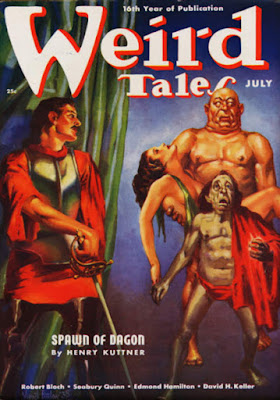Haunts of Showbiz
Horror and show business are often
intertwined by devilishly inventive creators . . .
The Phantom of the Opera,
familiar in novel and film form, concerns a cast-off fellow named Erik. After a stint with gypsies in their freak
show, Erik moves into the catacombs below the Paris Opera and begins a reign of
terror as he searches for the owner of the perfect female voice.
“Return to
the Sabbath,” by horrormeister Robert Bloch, first appeared in 1938. In this creepy little tale, a film producer
tracks down the star of a disturbingly realistic horror film and signs the fellow
as his next acting discovery. Trouble
ensues as we discover that the devil worshippers in the original film are real,
and want their revenge.
The story was
adapted in 1964 as “The Sign of Satan” for The Alfred Hitchcock Hour, starring
Christopher Lee as the horror actor whose death’s-head role becomes all too
true.
Fritz
Leiber’s 1965 story “Four Ghosts in Hamlet,” first printed in The Magazine of Fantasy and Science Fiction, concerns a traveling company that
accrues an extra ghost in the cast while performing Shakespeare, due to some
too-successful Ouija board sessions.
While the
trail of deaths that followed Karidian’s Shakespeare Troupe in Star
Trek’s 1966 “The Conscience of the King” were decidedly
non-supernatural, the uncertainty and suspense conjured by Barry Trivers’s
story make for a fun and unsettling hour of sci-fi TV.
The 1980
horror film Fade to Black features a psychotic movie buff who is spurned by
a Marilyn Monroe lookalike. He decides
to take revenge on his boss and other enemies, dressed as early movie stars—Karloff’s mummy, Cagney’s Cody
Jarrett, and Lugosi’s Dracula, among others.
Perhaps the ne plus ultra of showbiz horror is Bradford
Tatum’s 2016 novel Only the Dead Know Burbank. It tells the story of Maddy Ulm, an adolescent
German girl whose death in the 1918 Spanish Flu epidemic is only the beginning
of horrors. She rises, undead, in a
Berlin ravaged by WWI. After joining a German
film company, she singlehandedly creates the templates of film horror as she
journeys to Hollywood and Universal Studios.
She cuts the final version of Chaney’s Phantom; her traveling
partner, a wounded WWI soldier, inspires Jack Pierce’s design for the Frankenstein
Monster. Maddy also inspires the writer
of The
Wolf Man, and in other unbelievable ways lays the foundation for the
horror-media industry.
Perhaps now, through your knowledge, some of these ghosts have been laid …





















No comments:
Post a Comment